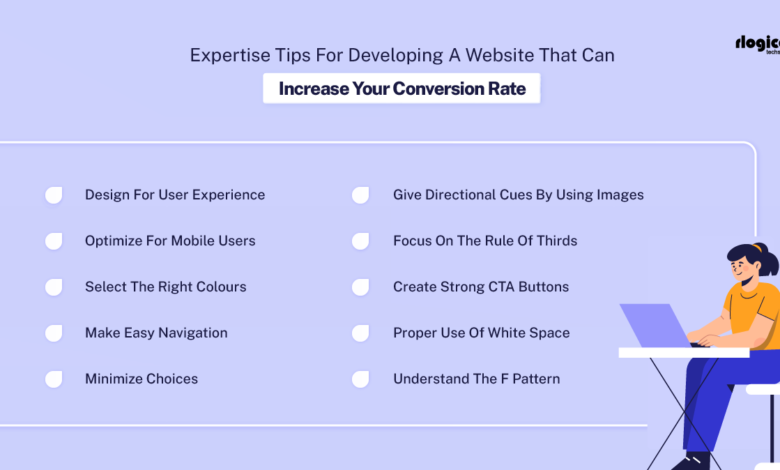7 Ways Customer-Centric Design Can Increase Your Website’s Conversion Rate

In today’s digital marketplace, your website is more than just a digital storefront; it’s a pivotal platform where customer interactions happen and decisions are made. A customer-centric web design addresses aesthetics and strategically enhances the user experience, ultimately leading to increased conversion rates. Here are seven effective design strategies to turn visitors into customers by focusing on customer-centric elements:
Enhance Website Speed
Website speed improves load times and enhances users’ perception of efficiency and professionalism. Every second counts, as a delay can drastically drop customer satisfaction and conversions.
To reduce loading times, utilize sophisticated methods such as deploying a Content Delivery Network (CDN), enhancing server efficiency, and applying enhanced caching techniques. Regularly monitoring your website’s speed using tools like Google PageSpeed Insights can provide ongoing insights into areas needing improvement.
Implement Responsive Design
Responsive design extends beyond screen adaptability, encompassing the holistic user experience on various devices. To maintain functionality and aesthetic integrity, ensure that navigation menus, images, and content layouts shift seamlessly between desktops, tablets, and smartphones.
Employ CSS media queries to accurately address various screen resolutions and adopt a mobile-first approach to cater to the increasing mobile user base. This approach caters to user preferences and boosts SEO as Google prioritizes mobile-friendly websites.
Utilize White Spaces
The strategic use of white space can dramatically enhance user focus and comprehension. Beyond just improving readability, white space can create a logical flow in the content, guiding users through your website in a way that naturally leads them to take action. Consider the spacing between lines, margins around text and images, and the overall layout to prevent cognitive overload. A clean design with ample white space enhances user interaction by eliminating distractions.
Optimize Calls to Action (CTAs)
CTAs are not just buttons but gateways to user engagement and conversion. Each call to action should be designed with a specific purpose, from signing up for a newsletter to completing a purchase.
Use persuasive, action-oriented language that conveys urgency and benefit, such as “Download Now to Improve Your Skills” or “Register Today and Start Saving.” Position CTAs in strategic locations based on user interaction patterns and consider varying their design to test which styles and phrases yield higher conversion rates.
Focus on User Experience (UX)
An exceptional user experience transcends simple navigation and aesthetic appeal—it involves anticipating the user’s needs and exceeding their expectations. Integrate interactive elements like chatbots for real-time assistance and personalized user journeys based on previous interactions.
Making accessibility a fundamental aspect of UX design ensures that every user, no matter their capabilities, can efficiently navigate your website. Regular UX audits can help identify friction points and opportunities for enhancements.
Leverage Color Psychology
The psychological impact of colors on consumer behavior is profound. Each color invokes specific emotions and actions. For instance, green is often associated with health and tranquility and can be effective for wellness brands, while red can create a sense of urgency and is frequently used in clearance sales.
The color strategy should align with your brand identity and the psychological cues you intend to trigger. Ensure consistency across all pages to positively reinforce brand recognition and influence user sentiment.
Incorporate High-Quality Visual Content
Quality visual content goes beyond resolution. It should tell a story and resonate with your target audience, reinforcing the message and values of your brand. Use authentic images that reflect real people and scenarios rather than generic stock photos to create a stronger connection with your audience.
Videos should be concise, engaging, and informative. They should provide value within the first few seconds to capture user interest. Visual content should be optimized for fast loading and responsiveness to maintain performance across all devices.
Advanced Tips to Boost Your Website’s Conversion Rate
Elevate your site’s effectiveness with these nuanced approaches to enhance user engagement and increase conversions:
●Adaptive Content Display: Personalize content based on visitors’ location, browsing history, or past interactions, such as displaying region-specific offers or products to enhance relevance and engagement.
● Enhance Micro-Interactions: Incorporate subtle micro-interactions, like hover effects and feedback animations, to make your website more interactive and responsive and enhance the overall user experience.
● Use Negative Cues Strategically: Employ negative cues, such as changing the ‘Delete’ button color to red on hover, to prevent accidental actions and reinforce user decision-making.
● Implement Live Chat Support: Integrate live chat to provide real-time assistance, addressing user questions immediately, which can help convert visitors who are hesitating to take the final step.
● Optimize Form Fields: Simplify form completion by reducing fields and using predictive text, enhancing user convenience and reducing abandonment rates.
● Test Exit-Intent Pop-Ups: Utilize exit-intent technology to present compelling messages or offers just as users are about to leave your site, providing a last-minute incentive to stay or convert.
● Incorporate Psychological Triggers: Apply psychological triggers like scarcity, urgency, and social proof to motivate quick decision-making and enhance conversion rates.
Conclusion:
In conclusion, employing customer-centric design principles is crucial for enhancing your website’s conversion rates. You can significantly influence visitor behavior and engagement by improving website speed, implementing responsive design, optimizing whitespace, crafting compelling CTAs, and ensuring an exceptional user experience. To see customer-centric design principles in action, check out this case study on good UX design.
Additionally, leveraging color psychology and incorporating high-quality visual content play pivotal roles in resonating with your audience and driving conversions. Incorporating these techniques alongside sophisticated methods like adaptive content display and deliberate micro-interactions, your website can effectively draw in visitors and transform them into dedicated customers.
Implement these insights to transform your site into a powerful conversion tool tailored to meet the needs and exceed the expectations of today’s savvy consumers.
Keep an eye for more news & updates on UsaTechMagazine. !




